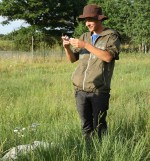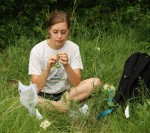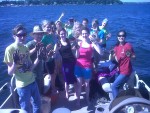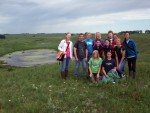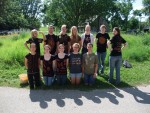It has long been acknowledged within the Long Term Ecological Research (LTER) Network that education is integral to the mission of the Network and that graduate students exemplify the spirit of that mission. As a tribute to the many students who spend many ours doing educational outreach to the community, in addition to their heavy workload in pursuit of a graduate degree, the Graduate Students Committee is sharing the following highlights with readers of LTER e-news.
Jane Cowles & Peter Wragg, Cedar Creek (CDR)
Jane Cowles and Peter Wragg have worked to enrich the internship program at Cedar Creek. Interns who participate in this program have the opportunity to design, do, and present an independent project on something that particularly interests them. Projects are collaborative research ventures between interns (singly or as a small group of up to four people) and mentors. The projects have the potential to lead to the development of new skills, exciting discoveries, presentations and, occasionally, peer-reviewed papers. They can range in scope from small observational studies to full-blown experiments. Most projects are research-related, but some are education or outreach focused. Each summer, approximately 20 interns participate in the projects and accompanying seminars that teach how to conduct research, meetings, and presentations.
Sylvia Lee, Florida Coastal Everglades (FCE)
Last summer, Sylvia Lee was an instructor for a high school summer camp where she taught diatom taxonomy and ecology. The Summer Diatom Camp for high school students was held at the Iowa Lakeside Laboratory, a biological research station in Milford, Iowa. Working with Lee (Florida International University) was Victoria Chraibi (University of Minnesota); both are alumnae of the graduate level diatom course (the “Ecology and Systematics of Diatoms”) offered at Lakeside every year. Lee and Chraibi developed the curriculum and instruction material for the 5-day camp, which featured 10 high school students from northwest Iowa.
The Summer Diatom Camp immerses students in the world of diatoms through collection of specimens from a variety of habitats, sample processing in the lab, microscopic observation of live and cleaned specimens, and lecture presentations on diatom ecology and morphological features of diatom genera. The camp intersperses academic activities with fun and interactive exercises, such as pontoon and canoe rides and diatom art. The camp ends with student group presentations to an audience of family and friends about their research projects and camp experiences. Lee will return to instruct the camp this summer with a new co-instructor.
Camille Beasley, Coweeta (CWT)
Camille Beasley is involved in outreach and education efforts informing landowners about bird species that occur within their property. She provides relevant biological and ecological information about those species in a letter addressed to the landowners. Beasley also teaches student volunteers how to band birds at the Big Bald banding station (bigbaldbanding.org) in North Carolina.

 Enlarge this image
Enlarge this image